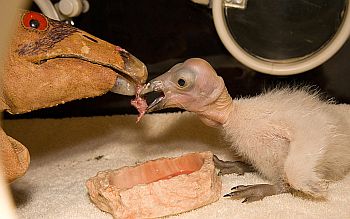Mexico City, Mexico - A binational effort to save the California condor has led to the establishment of the first Mexican breeding program for the endangered bird at the Chapultepec Zoo in Mexico City.
Wildlife biologists from the San Diego Zoo joined top environmental officials from both countries in the Mexican capital Monday to celebrate the new program.
Two female birds sent from the San Diego and Santa Barbara zoos are expected to breed with a pair of males sent to the Chapultepec Zoo from San Diego in 2007.
The creation of the breeding program "for us is not only a recognition of the Chapultepec Zoo, but a recognition for zoos across Mexico; that we can play an important role in the conservation of wildlife," Juan Arturo Rivera Rebolledo, head of Mexico City's Department of Zoos and Wildlife, said in a telephone interview.
Birds born at the Mexican zoo will be sent to the Sierra San Pedro Martir National Park in Baja California. Binational recovery efforts have been under way there since 2002 with the release of six condors that had been hatched in the United States, including the San Diego and Los Angeles zoos.
Michael Mace, curator of birds for the San Diego Zoo Safari Park, said the Mexican program marks a milestone in condor conservation, as biologists work to reintroduce populations of wild condors in their original habitat. Condors raised in breeding programs are now living in the wild in California, Arizona, Utah, and Baja California.
 |
| In 1982, the condor population plummeted to only 23. Efforts to save the species from extinction began in 1987 by the US Fish and Wildlife Service, placing all remaining wild condors in breeding programs at the San Diego and Los Angeles zoos. |
"They’re going to be able to raise their own condors to be released in Mexico," he said in an interview upon his return from Mexico City Tuesday.
The two female condors flown in separately from Los Angeles to Mexico City last month are known by scientists as "440" and "443." Mace said that they had been selected for their genetic compatibility with the males, named A-wai and Aquimowon, "to be able to produce viable offspring that one day will be flying free" in Baja California.
The California condor, with a wing span of more than nine feet and weighing up to 25 pounds, once ranged along the Pacific Coast from Baja California to British Columbia.
By the mid-20th century, the population plummeted, with only 23 surviving condors by 1982, according to the US Fish and Wildlife Service. Efforts to save the species from extinction began in 1987, when the service placed all remaining wild condors in breeding programs at the San Diego and Los Angeles zoos.
The binational recovery effort has been supported by the service’s "Wildlife Without Borders" program. A statement from the United States Embassy in Mexico City said that the plan is "for Mexican authorities, in the coming years, to take over all the aspects of the condor reintroduction."
There are now about 425 condors worldwide, with some 250 in breeding centers or holding pens waiting to be released, Mace said.
Michael Wallace, a conservation program manager for the San Diego Zoo "Institute for Conservation Research," said there are currently 27 of the birds flying loose in the Sierra San Pedro Martir National Park, with several pairs now breeding in the wild.
Original Story


